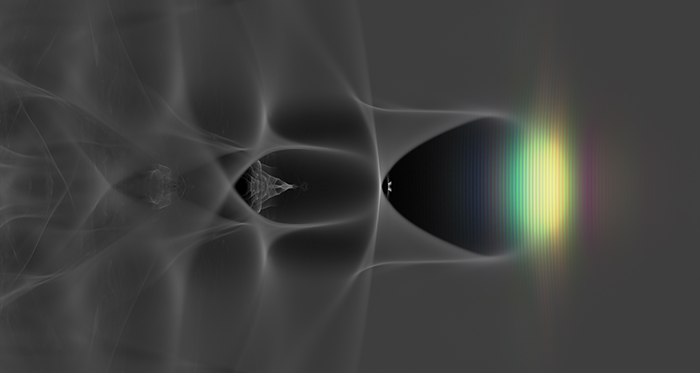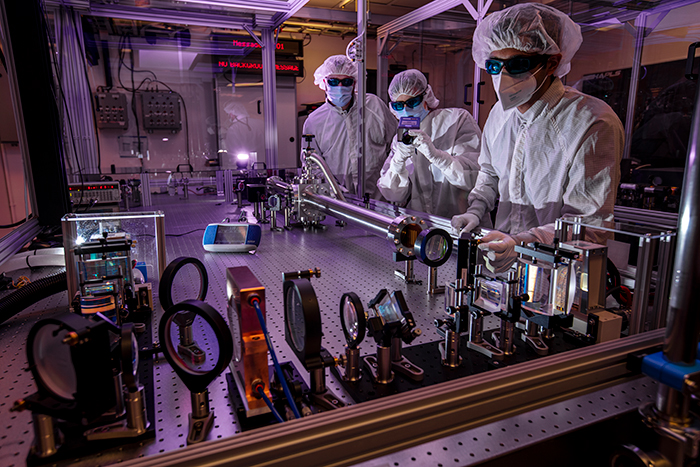
A key step in the production of muons: an ultra-intense short laser pulse accelerates electrons in the wake it leaves behind while propagating through a plasma. Simulation by LLNL's Josh Ludwig, in collaboration with University of Maryland and Lawrence Berkeley National Laboratory partners, on the Lassen HPC cluster supported by LLNL's Computing Grand Challenge Program for the ICMuS2 project.
Today we can see inside seemingly impossible places—nuclear reactors, volcanoes, tsunamis, hurricanes, and Egypt's Great Pyramid of Giza—thanks to muon imaging. This technique uses naturally occurring subatomic particles called muons, which can penetrate far deeper than possible with x rays through material as thick and dense as 30-meter concrete walls.
But this process is also slow. Due to the low flux of naturally occurring muons, these images require exposure times on the order of months. Scientists at Lawrence Livermore National Laboratory (LLNL) are working to change that with a new initiative called Intense and Compact Muon Sources for Science and Security (ICMuS2).
Partnering with industry and academic researchers, the initiative seeks to rapidly generate these particles using high power lasers. The project is funded by the Defense Advanced Research Projects Agency's Muons for Science and Security Program.
"Muons hold great potential across a range of applications," said Jeff Wisoff, Principal Associate Director at LLNL's National Ignition Facility and Photon Science Directorate. "This project will harness the lab's world-class laser technology and expertise to lay the groundwork for imaging breakthroughs."
Led by Brendan Reagan of LLNL's NIF and Photon Science Advanced Photon Technologies program, ICMuS2 will develop a technical design for a portable, laser-based muon emitter with orders of magnitude greater flux than naturally occurring muons that can be used in imaging across a wide range of applications. These include special nuclear materials detection, mining, and geophysics, among other uses.
"We have assembled a team of world leaders in the fields needed to meet the ambitious goals of DARPA's MuS2 Program," Reagan said. "This multi-faceted project combines high-power laser development, high-energy particle physics, plasma physics, advanced numerical simulations on high performance computing (HPC) systems, and systems engineering and integration. This is an exciting program that highlights the science and technology capabilities of the lab and the expertise of our partners."
This work is carried out in partnership with Extreme Light Infrastructure (ELI) European Research Infrastructure Consortium at the ELI Beamlines Facility in the Czech Republic, Colorado State University (CSU), University of Maryland (UMD), Lockheed Martin, XUV Lasers, and Lawrence Berkeley National Laboratory (LBNL). LLNL is also participating in a separate LBNL-led effort awarded under the MuS2 Program.
"Global partnerships are a key aspect of ELI's strategy and this builds on an already strong relationship we have with U.S. partners," said Allen Weeks, ELI's director general. "Participating in a DARPA-funded project is exciting because we can aim high to achieve something bold."
The muon detectors will be developed by CSU's Physics Department High Energy Physics Group under the direction of Professor John Harton.
"This project is a grand challenge for particle physics detection," Harton said. "The muon particles are outnumbered by huge factors by other particles, and we are using all the tools in the box to sift them out. This is particle physics with a practical application and we are glad to be involved."
Initial experiments will be conducted using UMD-developed plasma waveguides at CSU's Advanced Laser for Extreme Photonics (ALEPH) high-rep-rated petawatt laser facility. High energy acceleration and muon generation experiments will be conducted at ELI Beamlines using their L4-Aton 10 PW laser system.

ICMuS2 LLNL team members Drew Willard, Brendan Reagan, and Issa Tamer work on a prototype laser system that will be developed through this effort. Credit: Jason Laurea.
Aspects of this initiative build upon the Big Aperture Thulium (BAT) laser technology developed through LLNL's Lab Directed Research and Development (LDRD) program and investments in laser-driven accelerators made by the U.S. Department of Energy Office of Science's Offices of High Energy Physics and Accelerator Research & Development (R&D) and Production (ARDAP).
"The LDRD program pushes the frontiers in science and technology," said Doug Rotman, LDRD program director at the Lab. "Through this project, early-stage high risk investments in laser technology are helping deliver science discovery and improve national security."
The first phase of this four-year program will focus on proof-of-principle experiments and making a clear demonstration of laser-produced muons. The second phase will seek to demonstrate high energy muon production along with a design for a transportable muon source.
Other LLNL personnel directly participating in ICMuS2 include John Church, Blagoje Djordvic, Emily Edler, Tiffany Freitas, Justin Galbraith, Tom Galvin, Yvonne Garcia, Will Giles, Ben Haid, Zbynek Hubka, Elizabeth Hurtado, Shawn Johnson, Gabrielle Keller, Andreas Kemp, Nuno Lemos, David Lee, Josh Ludwig, Jim McCarrick, Jason Owens, Matt Rempel, Staci Riggs, Tom Spinka, Issa Tamer, Vincent Tang, Scott Wilks, Drew Willard, Jackson Williams, and Andrew Yandow.


